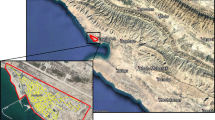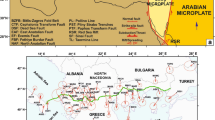Abstract
This paper was aimed to provide a quantitative failure probability analysis for multiple hazards. To achieve this, the 1724-kPa (250 Psi) gas pipelines of one of the district neighborhoods of Tehran metropolitan are analyzed to establish the probability of damage against earthquake, fire and liquefaction as a multi-hazard case study. The pipeline is approximately 4 km long and is divided into 14 segments, each of which has 300 m length. We used probabilistic analysis to identify the sources of earthquakes in the area. We calculated the probability that an earthquake with a given maximum magnitude will occur, the probability of liquefaction, that of post-earthquake fires, and the probability of pipeline failure for each segment. In order to take into account uncertainty in the location of epicenters, different points on the North Ray fault were randomly selected as epicenters, and the analysis was carried out for each point. Finally, based on the proposed method, the upper bound of failure probability of the main pipeline resulting from multiple hazards was estimated to be 65.7 %. If ductile pipelines were installed, this amount could be reduced to 32.7 % which shows a reduction of 51.79 % of the upper bound of failure probability.





Similar content being viewed by others
References
Adachi T (2007) Impact of cascading failures on performance assessment of civil infrastructure systems. A thesis submitted to the School of Civil and Environmental Engineering in partial fulfillment of the requirements for the degree Doctor of Philosophy, Georgia Institute of Technology
Adachi T, Ellingwood BR (2009) Serviceability assessment of a municipal water system under spatially correlated seismic intensities. Comput Aided Civil Infrastruct Eng 24(4):237–248
Aristizabal AG, Marzocchi W (2011) New methodologies for multi-hazard and multi-risk assessment methods for Europe, Seventh Framework Program, Matrix Projects
Cornell CA (1967) Bounds on the reliability of structural systems. J Struct Div Am Soc Civil Eng 93(ST1):171–200
Delmonaco G, Margottini C, Spizzichino D (2006) Report on new methodology for multi-risk assessment and the harmonisation of different natural risk maps. Deliverable 3.1, ARMONIA
Dziubinski M, Fratczak M, Markowski AS (2006) Aspects of risk analysis associated with major failures of fuel pipelines. J Loss Prev Process Ind 19(5):399–408
FEMA (Federal Emergency Management Agency) (1995) National mitigation strategy: partnerships for building safer communities. Tech. rep., Federal Agency Management Agency, Washington, USA
FEMA Federal Emergency Management Agency (1999) Earthquake loss estimation methods. HAZUS 99 SR2 technical manual
Gharabagh MJ, Asilian H, Mortasavi SB, Mogaddam AZ, Hajizadeh E, Khavanin A (2009) Comprehensive risk assessment and management of petrochemical feed and product transportation pipelines. J Loss Prev Process Ind 22(4):533–539
Ghodrati Amiri G, Mahdavian A, Manouchehri Dana F (2007) Attenuation relationships for Iran. J Earthq Eng 11(4):469–492
Greiving S (2006) Integrated risk assessment of multi-hazards: a new methodology. Spec Paper Geol Surv Finland 42:75
Jefferson T, Harrald J, Fiedrich F (2012) Linking infrastructure resilience to response requirements: the New Madrid Seismic Zone case. Int J Crit Infrastruct 8(1):22–46
JICA (2000) The study on seismic microzoning of the Greater Tehran Area in the Islamic Republic of Iran. Pacific Consultants International Report, OYO Cooperation, Japan
Kappes MS, Keiler M, von Elverfeldt K, Glade T (2012) Challenges of analyzing multi-hazard risk: a review. Nat Hazards 64(2):1925–1958
Krauthammer T, Tedesco JW (2008) A multihazard approach to insure resilient urban structures. Resilience of cities to terrorist and other threats. Springer, Netherlands, pp 259–272
Metropolo PL, Brown AEP (2004) Natural gas pipeline accident consequence analysis. Process Saf Prog 23(4):307–310
Pan American Health Organizatin (PAHO) (2011) Disasters demand a multi-hazard approach. http://www.paho.org/disasters/newsletter/index.php?option=com_content&view=article&id=468&Itemid=266&lang=en. Access in 20 Nov 2012
Rausand M, Høyland A (2004) System reliability theory: models, statistical methods, and applications, vol 396. Wiley, New York
Restrepo CE, Simonoff JS, Zimmerman R (2009) Causes, cost consequences, and risk implications of accidents in US hazardous liquid pipeline infrastructure. Int J Crit Infrastruct Prot 2(1):38–50
Simonoff JS, Restrepo CE, Zimmerman R (2010) Risk management of cost consequences in natural gas transmission and distribution infrastructures. J Loss Prev Process Ind 23(2):269–279
Statistical Center of Iran (2014) Iranian population and housing census in autumn 2011. http://www.amar.org.ir/Default.aspx?tabid=765
Tavakoli B (1996) “Major Seismotectonic Provinces of Iran”, International Institute of Earthquake Engineering and Seismology (IIEES), (in Persian), Tehran, Iran
Torres-Vera MA, Antonio Canas J (2002) A lifeline vulnerability study in Barcelona, Spain. Reliab Eng Syst Saf 80(2):205–210
WMO (2012) Disaster risk reduction (DRR) programme, multi-hazard early warning systems (MHEWS). http://www.wmo.int/pages/prog/drr/projects/Thematic/MHEWS/MHEWS_en.html. Access 26 May 2013
Zare M (2009) Fundamentals of seismic hazard analysis. International Institute of Earthquake Engineering and Seismology
Zare M, Ghafory-Ashtiany M, Bard P-Y (1999) Attenuation law for the strong-motions in Iran. In: Proceedings of the 3rd international conference on seismology and earthquake engineering, Tehran, vol 1, pp 345–354
Zolfaghari MR, Peyghaleh E (2008) Fire following earthquake modeling, probabilistic ignition model for stock, 14th world conference on earthquake engineering, China
Author information
Authors and Affiliations
Corresponding author
Rights and permissions
About this article
Cite this article
Omidvar, B., Kivi, H.K. Multi-hazard failure probability analysis of gas pipelines for earthquake shaking, ground failure and fire following earthquake. Nat Hazards 82, 703–720 (2016). https://doi.org/10.1007/s11069-016-2214-3
Received:
Accepted:
Published:
Issue Date:
DOI: https://doi.org/10.1007/s11069-016-2214-3




